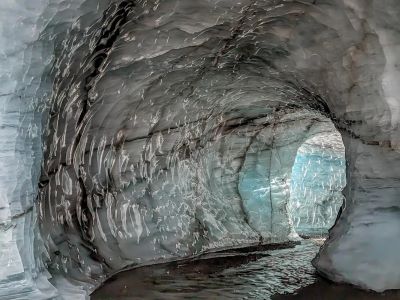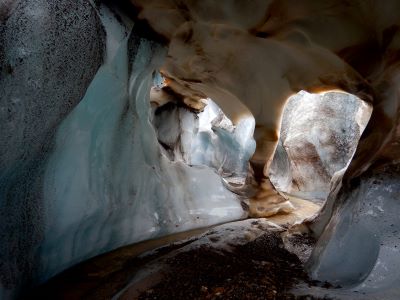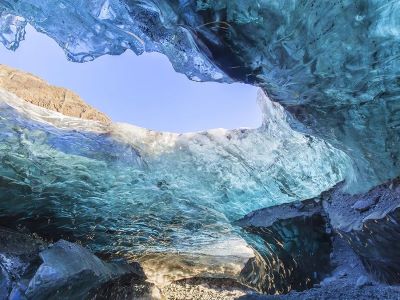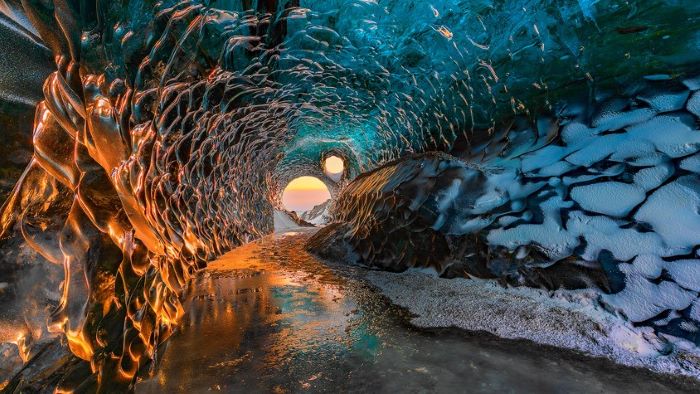Hello, fellow adventure seekers! I am back with the fantastic scoop on one of the most mind-blowing experiences in Iceland: ice caves, which one should have in life. Being surrounded by shimmering blue ice, untouched snow, and fresh air makes you feel you are in another world. Stay tuned if you also want to explore the jaw-dropping experience of these ice caves in Iceland.
For your information, I have compiled a quick guide to the breathtaking beauty of Iceland’s ice caves. Here, you will find every minor detail, from facts to the best time to visit Iceland for ice cave activities.
Ready to dive into the icy wonderland? Let’s start uncovering the magic of ice caves in Iceland together!
Is Ice Caves in Iceland Safe?
The short answer is yes. Ice caves in Iceland are safe, mainly when visited during winter, i.e., November to March, when ice is in its most stable form. For a secure experience, joining a guided tour led by experienced professionals who understand the cave conditions and can navigate the safest routes is essential. Additionally, visitors should always monitor the weather and ice conditions, as warm weather can make the ice more prone to collapse. Proper gear, including warm layered clothing, waterproof attire, and sturdy boots, is crucial to withstand the extreme cold inside the caves.

By adhering to these precautions and following your guide’s instructions, you can safely marvel at the breathtaking beauty of Iceland’s ice caves.
Which Is the Best Time to Visit Ice Caves in Iceland?
The best time to go ice caving in Iceland is typically from November to March. During these months, the weather is colder, which helps to stabilize the ice and reduces the risk of cave collapses. The shorter daylight hours also create optimal conditions for viewing the mesmerizing blue ice formations within the caves.
However, the exact timing can vary depending on location and current weather conditions. Therefore, you should consult local guides or tour operators for the most accurate and up-to-date information before planning your visit.
How Do Ice Caves and Tunnels Form in Iceland?
Apart from discussing the beauty and mesmerizing experience of ice caves in Iceland, it is also important to share some facts about this place and learn how the ice caves and tunnels were formed. The formation of these icy wonders is just as fascinating as the experience of visiting them. I have some essential points, which I will discuss in the following section, to give you more idea about this mesmerizing experience.
- When summer temperatures rise, glaciers’ surfaces melt and form channels. Over time, these channels carve out large spaces within the glacier, forming the ice caves and tunnels we see.
- Iceland is a volcanic hotspot, and geothermal heat is crucial in forming ice caves. In areas where geothermal activity is intense, the heat from below the glacier can melt the ice, which leads to stunning caves and tunnels. The combination of volcanic ash and ice often gives these caves a unique appearance.

- During the colder months, the caves and tunnels solidify and become safe for exploration. As winter approaches, the ice thickens, creating beautifully stable caves perfect for adventurers.
One of the most fascinating aspects of ice caves in Iceland is their transient nature. Due to the dynamic nature of glaciers, these caves and tunnels are constantly evolving. New caves are formed each year, and old ones might disappear or change shape. This makes every visit to an ice cave a unique experience.
Where Are the Best Ice Caves in Iceland?
Ah! You cannot miss out on exploring the best ice caves in Iceland. Walking into a world of icy, crystal-blue caves will give you a mesmerizing experience you will cherish all your life. Here are my top picks for the best ice caves in Iceland, which you should consider before making your trip:
| Ice Cave | Description |
| Crystal Ice Cave | This beauty is the most famous of them all. The photographer’s dream is the deep blue ice, glacial crevasses, and crystal-clear walls. |
| Katla Ice Cave | This gem is part of the Mýrdalsjökull Glacier. What makes it unique is the black volcanic ash mixed with the ice, giving it an otherworldly look. |
| Langjökull Ice Cave | For adventure seekers, this is a two-in-one treat. Not only do you get to explore an ice cave, but you also ride in monster trucks across Langjökull Glacier to get there. |
| Vatnajökull Ice Caves | The largest glacier in Europe hides some of the most beautiful and accessible ice caves. New caves are formed each year, making each visit a unique experience. |
Remember, these natural wonders are best explored with a guide. I recommend repeatedly getting the best ice cave tour for your experience. Tours are usually available from November to March when the caves are stable enough for exploration.
Which Ice Cave Tour Is Best in Iceland?
Are you planning to visit ice caves in Iceland? My buddy, you are on the right page!
Having recently experienced this myself, I can confidently say it’s an adventure like no other. However, you cannot take a risk alone to explore the ice cave experience; you must hire an ice cave tour.
For your benefit, I have jotted down the points to help you choose the best ice cave tour in Iceland, including costs and the exceptional hospitality you’ll encounter.
The Best Ice Cave Tours:
1. Vatnajokull Glacier Ice Cave Tour
Ah! This tour is one of the best ones. It will take you to the heart of Vatnajokull, Europe’s largest glacier. They start their journey by picking you up at the Jokulsarlon Glacier Lagoon and driving you to the ice cave. This tour includes short, easy hiking so that people of every age can enjoy the experience. Here, you will witness the mesmerizing hues of ice formation, which are captured into your camera lens. Tour costs will be around $155 per person if we discuss the cost.
2. Katla Ice Cave Tour
This tour starts in Vik and takes you to the Katla ice cave under the Myrdalsjokull glacier. You will have an excellent jeep journey and the chance to see the volcanic ash layers, making this ride stand out. In addition, the view of black volcanic ash and able ice contrast gives a surreal landscape view, which you will not want to miss. If we talk about the cost of this tour, it will be around USD 220 per person. Overall, this tour is perfect for those who want to have a shorter adventure lifetime experience.
3. Two-Day Ice Cave & South Coast Tour
If you have time, I suggest you extend your trip and experience the ice cave in Iceland via this tour. It will offer you a more immersing experience, as this two-day tour will take you to multiple ice caves and iconic sites, and you will also get a chance to explore Iceland’s south coast zone. It will cost you approximately USD 659 per person.
You know what? The highlight of this tour is that you will explore the famous Crystal Ice Cave and the breathtaking Jokulsarlon Glacier Lagoon. Additionally, the tour ensures high hospitality, making participants feel welcome and comfortable throughout the excursion.

From the moment you book your tour, you’ll be in the hands of experienced guides passionate about sharing Iceland’s natural wonders. They provide all necessary safety gear, including helmets and crampons, and ensure you’re comfortable and well-informed throughout the journey. The guides are not only knowledgeable about the ice caves but also about Icelandic culture and history, adding depth to your adventure. Their enthusiasm is contagious, making the experience even more enjoyable.
Visiting an ice cave in Iceland is a once-in-a-lifetime experience. An ice cave tour is a must-do activity that will leave you with memories to cherish forever. So, pack your warm clothes, grab your camera, and get ready. Trust me, you won’t regret it.
FAQs
Can you visit ice caves in Iceland on your own?
Visiting ice caves in Iceland alone is not recommended, as they can be dangerous and unpredictable. The caves are located in glacier areas where conditions can change rapidly. It’s better to visit ice caves with an experienced guide who is familiar with the area. Various tour operators in Iceland offer guided ice cave tours, which provide safer and more informative experiences.
Where are the blue ice caves in Iceland?
Iceland’s blue ice caves can be found in various locations, but Vatnajökull is Europe’s largest glacier. Other popular locations for blue ice caves are Breiðamerkurjökull Glacier and Svínafellsjökull Glacier.
How many ice caves are there in Iceland?
According to research, there are numerous ice caves in Iceland, and giving an exact number is impossible because new ice caves are formed yearly, and older ones melt or collapse. However, several notable ice caves are famous among tourists, such as Katla Ice Cave, Langjökull Ice Cave, Crystal Cave, and Blue Ice Caves.
Which is the biggest ice cave in Iceland?
The biggest ice cave in Iceland is the Vatnajökull ice cave, located in Vatnajökull National Park. It is Europe’s largest ice-cp glacier, and witnessing this breathtaking natural wonder is worth it once in a lifetime.

